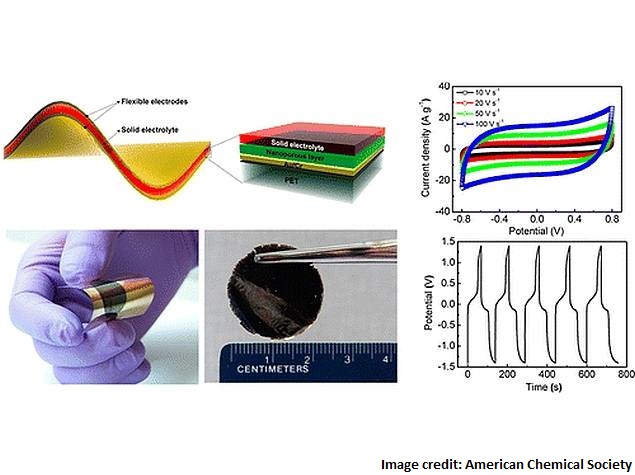- Home
- Wearables
- Wearables News
- New thin film batteries to help usher in bendable, wearable electronics
New thin-film batteries to help usher in bendable, wearable electronics

James Tour and his colleagues at Rice University have developed a flexible material with nanoporous nickel-fluoride electrodes layered around a solid electrolyte to deliver battery-like super-capacitor performance.
The material combines the best qualities of a high-energy battery and a high-powered super-capacitor without the lithium
found in commercial batteries today, researchers said.
The electrochemical capacitor is about a hundredth of an inch thick but can be scaled up for devices either by increasing the size or adding layers, said Yang Yang, co-lead author of the research paper with graduate student Gedeng Ruan.
Researchers expect that standard manufacturing techniques may allow the battery to be even thinner.
In tests, they found their square-inch device held 76 percent of its capacity over 10,000 charge-discharge cycles and
1,000 bending cycles.
Tour said the team set out to find a material that has the flexible qualities of graphene, carbon nanotubes and conducting polymers while possessing much higher electrical storage capacity typically found in inorganic metal compounds.
Inorganic compounds have, until recently, lacked flexibility, he said.
"Compared with a lithium-ion device, the structure is quite simple and safe," he said.
"It behaves like a battery but the structure is that of a super-capacitor. If we use it as a super-capacitor, we can
charge quickly at a high current rate and discharge it in a very short time. But for other applications, we find we can set it up to charge more slowly and to discharge slowly like a battery," said Tour.
To create the battery/super-capacitor, the team deposited a nickel layer on a backing. They etched it to create 5-nanometre pores within the 900-nanometre-thick nickel fluoride layer, giving it high surface area for storage.
Once they removed the backing, they sandwiched the electrodes around an electrolyte of potassium hydroxide in polyvinyl alcohol.
The finding is detailed in the Journal of the American Chemical Society.Catch the latest from the Consumer Electronics Show on Gadgets 360, at our CES 2026 hub.
Related Stories
- Samsung Galaxy Unpacked 2025
- ChatGPT
- Redmi Note 14 Pro+
- iPhone 16
- Apple Vision Pro
- Oneplus 12
- OnePlus Nord CE 3 Lite 5G
- iPhone 13
- Xiaomi 14 Pro
- Oppo Find N3
- Tecno Spark Go (2023)
- Realme V30
- Best Phones Under 25000
- Samsung Galaxy S24 Series
- Cryptocurrency
- iQoo 12
- Samsung Galaxy S24 Ultra
- Giottus
- Samsung Galaxy Z Flip 5
- Apple 'Scary Fast'
- Housefull 5
- GoPro Hero 12 Black Review
- Invincible Season 2
- JioGlass
- HD Ready TV
- Laptop Under 50000
- Smartwatch Under 10000
- Latest Mobile Phones
- Compare Phones
- Tecno Spark Go 3
- iQOO Z11 Turbo
- OPPO A6c
- Samsung Galaxy A07 5G
- Vivo Y500i
- OnePlus Turbo 6V
- OnePlus Turbo 6
- Itel Zeno 20 Max
- Lenovo Yoga Slim 7x (2025)
- Lenovo Yoga Slim 7a
- Lenovo Idea Tab Plus
- Realme Pad 3
- Garmin Quatix 8 Pro
- NoiseFit Pro 6R
- Haier H5E Series
- Acerpure Nitro Z Series 100-inch QLED TV
- Asus ROG Ally
- Nintendo Switch Lite
- Haier 1.6 Ton 5 Star Inverter Split AC (HSU19G-MZAID5BN-INV)
- Haier 1.6 Ton 5 Star Inverter Split AC (HSU19G-MZAIM5BN-INV)







![[Sponsored] Haier C90 OLED TV | Dolby Vision IQ, 144Hz OLED and Google TV in Action](https://www.gadgets360.com/static/mobile/images/spacer.png)









